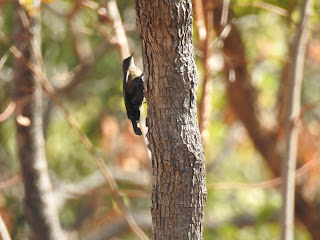We awoke at the usual ridiculously early hour, having some trouble finding a place to park our car before we boarded a tour bus arranged for us. We were happy to see Luke and his wife Sarah were guiding us on this trip again. As was true previously, their skills would prove extremely useful at finding a variety of birds we would absolutely have missed on our own.
On arrival at the site, we walked through some dry woodland heading towards the billabong, splitting into 3 groups. My dad and I decided to go with the group lead by Luke. We came across several of the honeyeaters we'd seen earlier, getting great views of an immature banded honeyeater and a bar-breasted honeyeater among others. Many white-winged trillers were also present, and 2 tree martins were for once seen perching still, a rare opportunity for half-decent photos of the species.
BANDED HONEYEATER
BAR-BREASTED HONEYEATER
TREE MARTIN
Upon arriving at the wetlands themselves, we began gradually walking around them. The usual host of Top End waterbirds was observed: plumed whistling-ducks, green pygmy geese, jabirus, magpie geese, pied herons, wandering whistling-ducks, glossy ibises, grey teal, white-naped stilts, black-fronted dotterels, whiskered terns and Radjah shelducks (among others) all gave fairly good views. A roosting Nankeen night-heron and a dusky moorhen were highlights, the latter being a relatively rare vagrant to the Top End. At one point we observed a Jabiru struggling with a water snake for a few minutes, before eventually managing to kill and swallow it.
PIED HERON
WANDERING WHISTLING-DUCK
WHITE-NAPED STILT
GLOSSY IBIS
JABIRU
MAGPIE GOOSE
GREEN PYGMY-GOOSE
As we made our circuit we ran across the other groups, who had come across a rare grey-fronted honeyeater on their walk. Try as we might, we could not refind this bird, and had to settle for silver-crowned friarbirds and red-collared lorikeets feeding at blossoming eucalypts on our way back.It wasn't till we left the site that one of my favourite birdwatching moments to date occurred. As we passed through an area of dry woodland near the site, I asked if we could get a chance to stop and search for black-tailed treecreeper. Luke initially was unsure we would make it back to Darwin on time, but after seeing one from the vehicle agreed to make a brief stop, which could double as a visit to a nearby public bathroom.
We followed my life black-tailed treecreeper a short distance into the woodland, when Luke suddenly stopped us with a whisper of "finches up ahead" followed by an ecstatic "GOULDIANS! GOULDIANS!"
4 or 5 stunning GOULDIAN FINCHES were feeding in the grass up ahead, most of which were in adult plumage. Among them was a brilliantly coloured, red-headed male, which my poor photos could not possibly do justice.
BLACK-TAILED TREECREEPER
GOULDIAN FINCH
We left Mary River feeling absolutely blessed. To further add to this, upon our return to Darwin a grey goshawk was soaring overhead, a species which I have only seen a few times before and never gotten very good views of.After a brief rest, we headed to Stokes Hill Wharf, where we were to board a boat and search for chestnut rails. At the wharf itself we observed two roosting great cormorants, along with many black kites attracted by the smell of food from the many nearby restaurants. The boat itself was comfortable, and offered free water.
As we neared the mangroves, we immediately observed several egrets, striated herons, an Australasian darter and an azure kingfisher, along with a distant white-breasted sea eagle. In the mangroves themselves we were treated to crippling views of 5 chestnut rails. This usually secretive species seemed completely unafraid of our boat, striding along the mudflats right in front of us. A single Torresian kingfisher was also observed, although I didn't manage to get any photos of it at all. The cruise ended with views of a very sought-after bird totally unlike the expected "5-second look at a bird dashing between mangroves" and I would highly recommend a boat trip around Darwin's mangroves at low tide as a way to see this species. As we left the mangroves we also got distant views of a beach stone-curlew. This marked the end of our Top End adventure, and we left Darwin at around 10 am the following morning.
CHESTNUT RAIL
STRIATED HERON
All in all, the trip was extraordinarily successful, involving great views of species that I hadn't thought I'd see for a long while to come. The main species we dipped on were most of the mangrove passerines (mangrove golden whistler, mangrove robin, mangrove grey fantail, etc.), Arafura fantail, black-breasted buzzard, all the area's buttonquail species and all Kakadu's sandstone specialties (since we did not visit Kakadu at all). On a future trip, I would seek to spend more time at Charles Darwin National Park (hopefully with actually functioning insect repellent), spend one or two nights in Jabiru so we could search for sandstone specialties at Ubirr in the morning, and make a visit to Holmes Jungle Nature Reserve to try for the buttonquails. I'd probably try to track down Arafura Fantail at Fogg Dam along the monsoon forest walk. However, I was left very satisfied by my experiences in Darwin, and despite the questionable timing of the trip in the middle of Year 12 I would happily do it all again.














No comments:
Post a Comment